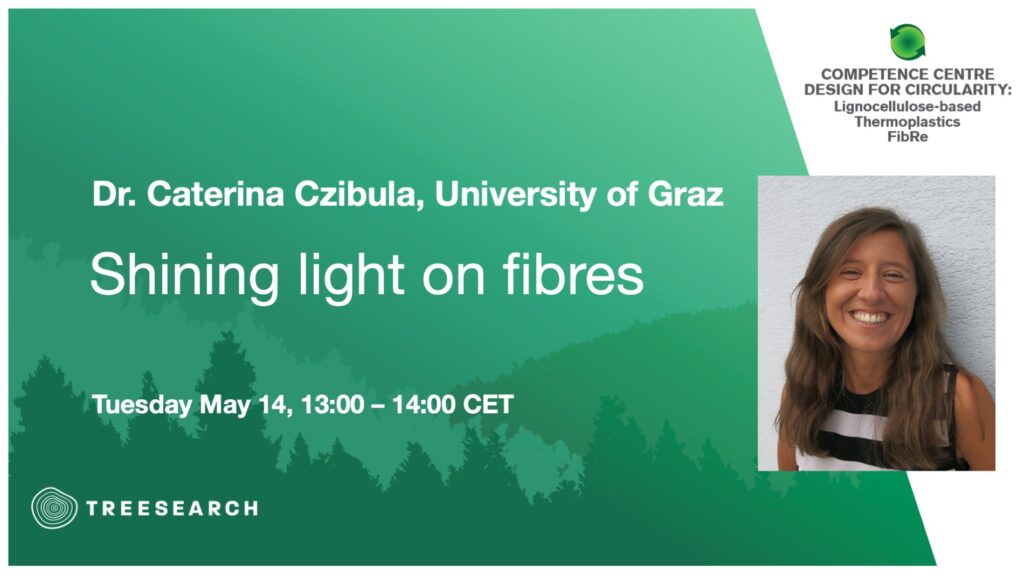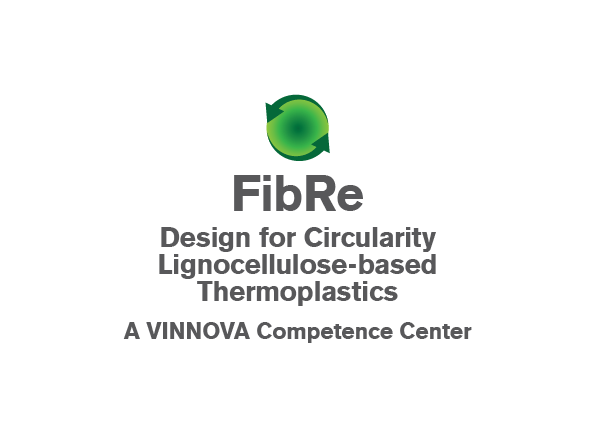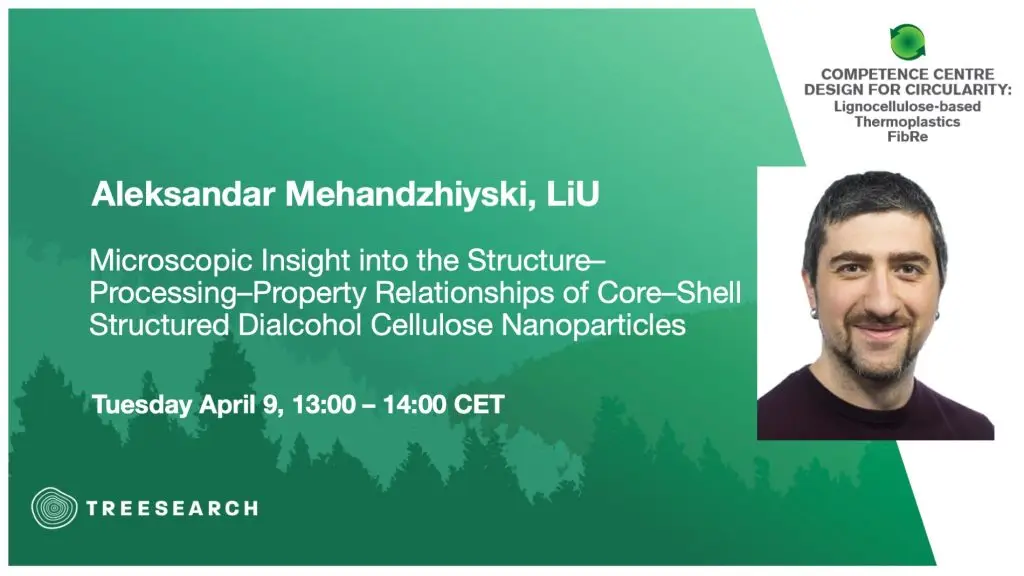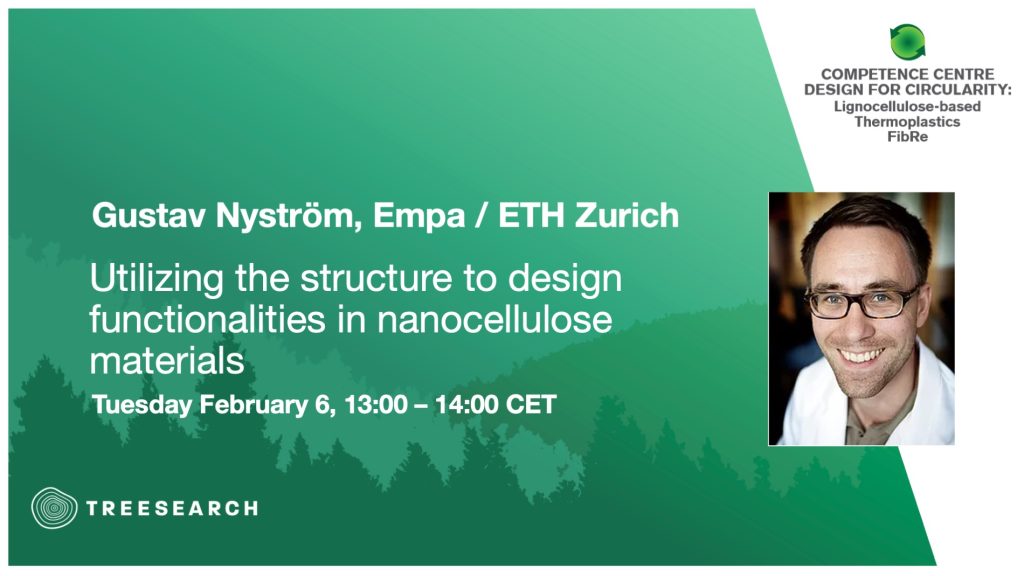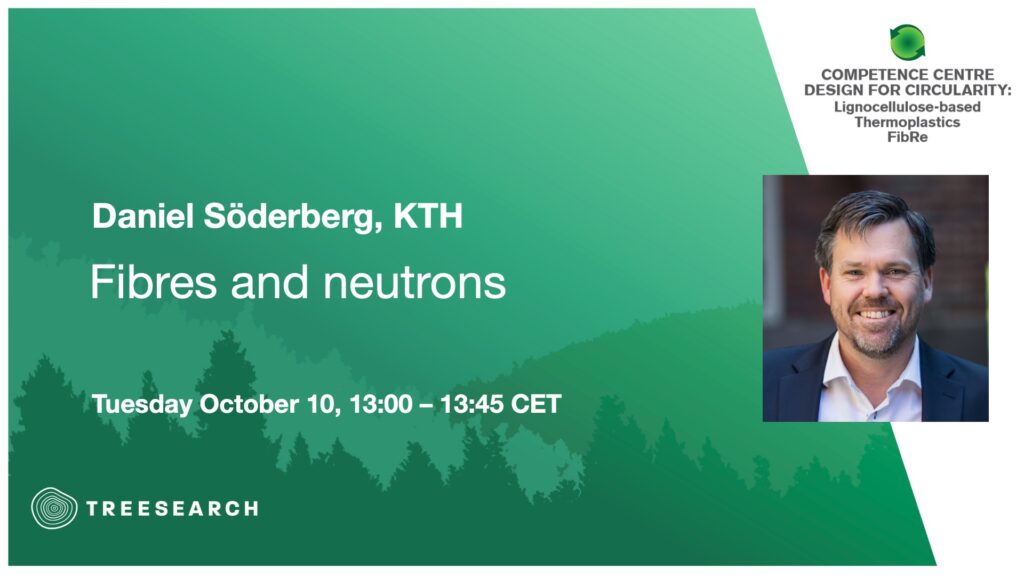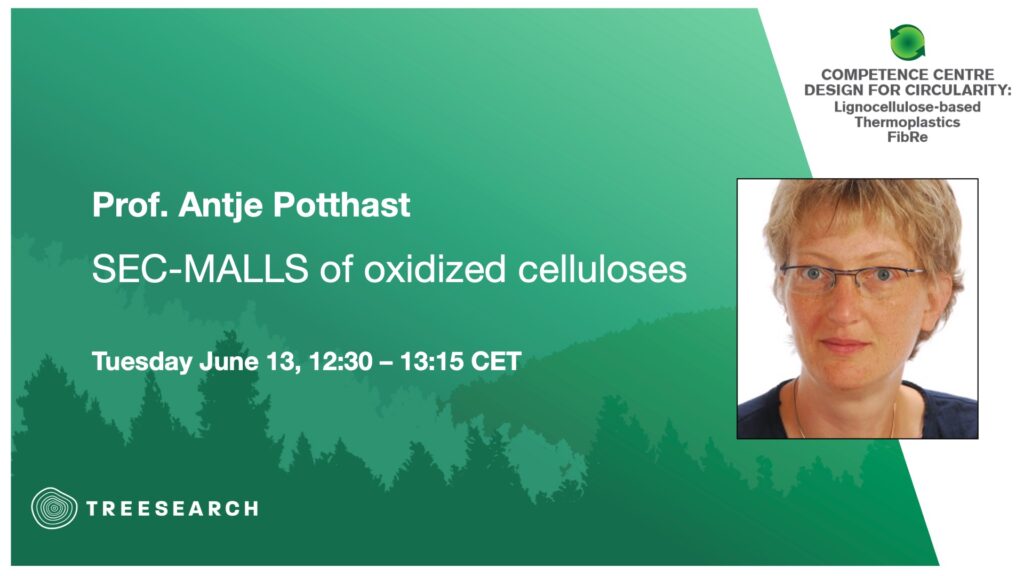FibRe and Treesearch online seminar series
Welcome to join us in an online seminar series together with the Vinnova competence center FibRe! You can register for each seminar to join the webinar or tune in the live-stream on Treesearch’s YouTube channel.
Next seminar May 14, 13:00 – 14:00 CET
Dr. Caterina Czibula, University of Graz
Shining light on fibres
Caterina Czibula is a postdoctoral researcher at the Institute of Bioproducts and Paper Technology at Graz University of Technology with a background in materials science. Her material passion are cellulosic fibers and her goal is to bring their micromechanical characterization to a new level. In her Hertha Firnberg fellowship of the Austrian Science Fund, she started to implement Brillouin spectroscopy as a non-contact, optical technique for the mechanical characterization of single cellulosic fibers.
The Vinnova competence center FibRe started 2020 and is one of the largest research initiatives on new materials from the forest in Sweden. In FibRe, the partners from academia, industry and public sector combine their expertise to develop thermoplastic lignocellulose-based materials and the needed competence with specific focus on
1) modification
2) advanced characterization
3) processing.
The seminars are available to watch afterwards at Treesearch’s YouTube channel, where you also can find more other research seminars
Previous presentations in the FibRe and Treesearch online seminar series
Click on the video thumbnail to go directly to the recording on YouTube
Aleksandar Mehandzhiyski, Linköping University
Microscopic Insight into the Structure–Processing–Property Relationships of Core–Shell Structured Dialcohol Cellulose Nanoparticles
February 6, 2024
Dr Aleksandar Mehandzhiyski is Principal Research Engineer at the Laboratory of Organic Electronics (LOE) at Linköping University.
Gustav Nyström, Empa / ETH Zurich
Utilizing the structure to design functionalities in nanocellulose materials
February 6, 2024
Dr Gustav Nyström is Head Cellulose & Wood Materials at Empa and Lecturer at Department of Health Sciences and Technology ETH Zurich.
His current research interests are centered on the use of cellulose and wood as a basis for new smart materials with embedded functionalities. Gustav Nyström has a strong focus on the material structure and use this as a starting point to understand how these structures can be optimally used in new materials. The goal is to improve or introduce completely new functionalities that are inherently coded in the materials themselves. Tools of specific interest include self-assembly mechanisms, 3D printing, physical templating and interactions with other biological building blocks or microorganisms in biohybrid materials.
Before joining Empa he was a senior scientist at ETH Zurich as a member of the Food & Soft Materials group and a postdoctoral fellow in the Department of Polymer and Fibre Technology at KTH Royal Institute of Technology. Gustav Nyström received his PhD in the Nanotechnology and Functional Materials group at Uppsala Unviversity. He is the recipient of the Gunnar Sundblad Research Foundation’s Skills Development Prize (2014), an ETH Zurich Career Grant (2016), an SNSF Ambizione Fellowship (2016) and the KINGFA Young Investigator Award (2020) from the Cellulose and Renewable Materials division of the American Chemical Society.
Prof. Roland Kadár, Chalmers
On the processing of wood fiber biocomposites
November 28, 2023
The processing of soft matter into products typically involves rheologically complex fluids in complex flow configurations. Thus, understanding flow-field-matter/compositional interactions in relation to fundamental rheological properties is essential for obtaining products with favorable performance.
In this framework, the staples of Roland’s research and current related activities and interests are:
(i) Advanced characterization methods, method development – focused on nonlinear material characterization and hyphenated rheological techniques, e.g. rheo-microscopy, rheo-SAXS, mainly applied to nanocellulose suspensions, polymer nanocomposites, adhesives and biomaterials (biofilms, tissues).
(ii) Tailoring multifunctional properties in nanostructured materials – focused on the process structuring of polymer nanocomposites based on graphene and other high aspect ratio fillers for enhanced electrical, antibacterial, thermal, mechanical, gas-barrier etc. properties.
(iii) Dynamics of simple and complex fluids for processing applications – focused on modeling, processing flow and compositional optimization of high filler content bicomposites and flow-assisted structuring of nanocrystalline cellulose dispersions.
Roland is PI in the Wallenberg Wood Science Centre and the Vinnova Competence Centre ‘2D material-based technology for industrial applications’
Prof. Daniel Söderberg, KTH
Fibers and neutrons
October 10, 2023
Professor Daniel Söderberg’s main focus is to develop an understanding of the physical phenomena and mechanisms used by nature and to find means of applying this knowledge for developing new and improved industrial processes and materials for society. As a starting point, bio-based components are used, as the smallest constituents of wood fibres: cellulose nanofibrils. The goal is to develop new processes that not only work in a lab environment but can also be scaled for industrial production of new high-performance bio-based materials.
https://www.kth.se/fpt/fibre-processes/division-of-fibre-processes-1.1057679
Prof. Antje Potthast, BOKU
SEC-MALLS of oxidized celluloses
June 13, 2023
Dr. Antje Potthast is professor (Chemistry of lignocellulosic materials) at the University of Natural Resources and Life Sciences, Vienna (BOKU). She works with analysis and modification of biopolymers, especially cellulose and lignin in very different research areas including analytical method development, speed analysis for lignin characterization, methods for cellulose modification and application strategies for lignocellulose biopolymers.
Dr Alistair King, VTT
Solution-state NMR analysis of cellulosic materials
April 18, 2023
Dr. Katja Heise, Aalto University
Cellulose nanocrystals - from spatioselective modifications to advanced molecular analysis by solution-state NMR spectroscopy.
October 25, 2022
Prof. Daniel Söderberg, KTH
How mechanisms controlling macroscopic fibre suspensions impact nanofibrillar systems
September 20, 2022
Professor Daniel Söderberg’s main focus is to develop an understanding of the physical phenomena and mechanisms used by nature and to find means of applying this knowledge for developing new and improved industrial processes and materials for society. As a starting point, bio-based components are used, as the smallest constituents of wood fibres: cellulose nanofibrils. The goal is to develop new processes that not only work in a lab environment but can also be scaled for industrial production of new high-performance bio-based materials.
https://www.kth.se/fpt/fibre-processes/division-of-fibre-processes-1.1057679
Dr Paavo Penttilä, Aalto University
X-ray and neutron scattering studies of wood nanostructure and moisture interactions
June 14, 2022
Dr. Paavo Penttilä is an Academy of Finland Research Fellow and the leader of the “Biobased materials structure” research team at Aalto University, Finland. He finished his PhD in materials physics at the University of Helsinki in 2013, and spent in total 4.5 years as postdoc at Kyoto University, Japan, and Institut Laue-Langevin, France. Dr. Penttilä’s research evolves around the application of X-ray and neutron scattering on studying the nanoscale structure of wood and other biobased materials. He is the developer of the “WoodSAS” model for analyzing small-angle scattering data from wood. Most recently, his work has focused on the role of water in the wood cell wall.
Professor Daniel Cosgrove, Penn State University
Relating cell wall structure to cell wall mechanical properties: experiments and modeling
April 5, 2022
Professor Daniel Cosgrove studies the mechanism of plant cell growth, with a focus on the structure of extensible plant cell walls and the mechanisms by which they stretch irreversibly during growth. His group discovered a group of wall-loosening proteins named ‘expansins’ that are central to plant growth. Cosgrove and collaborators use biophysical, molecular and genomic approaches to understand the molecular activities of expansins, as well as their biological functions and their evolution. He is the founding Director of the Center for Lignocellulose Structure and Formation, an Energy Frontiers Research Center funded by the US Department of Energy since 2009, a coordinated effort by 16 research groups in seven universities and Oak Ridge National Laboratory. The center’s mission is to develop a nanoscale understanding of cellulosic cell walls, the energy-rich structural material in plants, forming the foundation for new technologies in sustainable energy and novel biomaterials. Following his undergrad and grad studies at the University of Massachusetts and Stanford University, he went to Germany and Seattle for research visits before joining the Biology Department at polysaccharides.
Professor Herbert Sixta, Aalto University
Advances in Ioncell technology for the sustainable production of textile and technical fibers
February 8, 2022
Professor Herbert Sixta has 30 years of experience in industrial research on pulp and cellulose chemistry. The scope was extended to biorefineries after his research career started in 2007 at Aalto University. Prof. Sixta’s core interest comprises the use of tailored ionic liquids for the selective dissolution of different biopolymers as a novel way of biomass fractionation. In material science the focus is laid on the development of high added-value cellulose material regenerated from ionic liquid solution as well as the synthesis of building block chemicals by heterogeneously catalyzed conversion routes from polysaccharides.
Associate Prof. Emily Cranston, UBC
Advances (and Challenges) in the Surface Modification of Cellulose Nanocrystals
December 7, 2021
Dr. Emily D. Cranston is an Associate Professor in Wood Science/Chemical & Biological Engineering at the University of British Columbia (Canada) and is the President’s Excellence Chair in Forest Bioproducts. Prior to 2019, she was an Associate Professor at McMaster University and Canada Research Chair in Bio-Based Nanomaterials. Emily’s research focuses on the colloid and surface chemistry of sustainable nanocomposites and hybrid materials from (nano)cellulose and other biopolymers. Her work attempts to bridge gaps between industrial producers of nanocellulose and potential end users by exploring fundamentals.
Emily received both her degrees from McGill University, an Honors BSc in Chemistry (2001) and a PhD in Materials Chemistry (2008) in the group of Professor Derek Gray. The study of value-added products from cellulose took her to Stockholm, Sweden as a postdoctoral researcher at KTH Royal Institute of Technology before she returned to Canada in 2011. Emily has published over 120 scientific papers and reviews and has trained 90 researchers. She was awarded the KINGFA Young Investigator’s Award (2016) and the Kavli Emerging Leader in Chemistry Lectureship (2018) from the American Chemical Society. In 2021, Emily received the TAPPI Nano Technical Award, the La Sueur Memorial Award from the Society of Chemical Industries of Canada and an E.W.R. Steacie Memorial Fellowship (awarded to six early stage academic researchers nationally) from the Natural Sciences and Engineering Research Council of Canada.
Read more about the research at cranstongroup.forestry.ubc.ca
Dr. Benjamin Watts, PSI
Soft X-ray Spectroscopy and Microscopy of Organic Materials
October 12, 2021
Benjamin Watts is a beamline scientist at the PolLux scanning transmission soft X-ray spectro-microscope (STXM) specialising in the materials analysis of soft matter. He obtained a BSc (Professional) in Physics, with Honours, and a PhD in Physics from the University of Newcastle, Australia, before working as a post-doctoral researcher with North Carolina State University (permanently stationed at the Advanced Light Source, Berkeley) in the USA and then moving to PSI. Details of the interactions between soft X-ray light and organic materials has been a continuing theme throughout both his university research and later career.
The core of Benjamin Watts’ research involves the use of soft X-ray spectroscopy and microscopy of organic materials, especially near-edge X-ray absorption fine structure (NEXAFS or XANES) spectroscopy at the carbon K-edge and scanning transmission X-ray microscopy (STXM). C K-edge NEXAFS provides spectral fingerprints corresponding to types of molecular bonding present in the sample material and so allows differentiation between organic materials based on their molecular structure. X-ray microscopy techniques such as STXM can then utilise this spectroscopy as a contrast mechanism to create quantitative nanoscale maps of materials properties such as composition, molecular conformation and mass density. Of particular interest is the imaging of nano-structures in conjugated polymer based electronic devices, such as OLED’s and polymer solar cells, which are creating revolutions in the digital display and energy industries. Benjamin Watts also has strong interest in developing novel data analysis methods, improved data collection and storage formats, and the programming of data analysis tools with graphical user interfaces, which each represent key facets of the dissemination of knowledge.
Prof. Denis Rodrigue, Univversité Laval
Surface treatment of lignocellulosic fibres for polymer composite applications
May 4, 2021
Denis Rodrigue obtained a B.Sc. (1991) and a Ph.D. (1996) in chemical engineering from Université de Sherbrooke (Sherbrooke, Canada) with a specialization in non-Newtonian fluid mechanics. In 1996 he moved to Université Laval (Quebec City, Canada) where he is now full professor. Since then, he has been an invited professor at the University of Guadalajara (Mexico), the Technical Institute of Karlsruhe (Germany), the University of Castilla-La Mancha (Spain), the University of Arts and Sciences of Hunan (China), the Technical University of Lodz (Poland) and the University François Rabelais of Tours (France).
His main research areas are in the characterization and the modelling of the morphological / mechanical / thermal / rheological properties of polymer foams and composites based on thermoplastics and elastomers. His main focus is related to polymer recycling and rheology.
He is the co-editor of two international journals:
- Current Applied Polymer Science
- Journal of Cellular Plastics
and a member of the editorial board of three others:
- Applied Sciences, Section Materials
- Cellular Polymers
- Elastomery
Prof. Hiroyuki Yano, RISH, Kyoto University
NCV: nano cellulose vehicle and CNF materials for structural application
April 13, 2021
Hiroyuki Yano is a Professor at the Research Institute of Sustainable Humanosphere (RISH) at Kyoto University. His research involves extraction of nanofibers from biomass resources and their utilization as a component of nanomaterials for optical and structural purposes. In 2016 he received the prestigious Honda Prize for his Contributions to the Development of a High-efficiency Production Method of Cellulose Nanofiber, Its Application to Products, and the Enhancement of Its Potential for Further Utilization (shared with professor Akira Isogai).
Professor Yano is a project leader in the NCV Project where 22 Japanese research actors and manufacturers joined together with support from the Japanese government to make Nano Cellulose Vehicles.
Prof. Orlando Rojas, UBC
Opportunities for using lignin in supramolecular and colloidal structures
March 16, 2021
Professor Orlando Rojas received his PhD in Chemical Engineering from Auburn University (1998), USA, followed by an appointment as Senior Researcher in the KTH Royal Institute of Technology, and the Institute for Surface Chemistry, YKI, both in Stockholm. Currently, Prof. Rojas is a Canada Excellence Research Chair in University of British Columbia. In this condition he is the Director of the Bioproducts Institute and shares affiliation with three departments of Chemical and Biological Engineering, Chemistry and Wood Science. Part of his research group (Bio-based Colloids and Materials) also operates in Aalto University, Finland, where he is visiting professor.
Prof. Rojas received the Anselme Payen Award, established by the American Chemical Society in 1962, the highest recognition in the area of cellulose and renewable materials. In addition, Prof. Rojas is an elected as Fellow of the American Chemical Society (2013), the Finnish Academy of Science and Letters (2017) and recipient of the Tappi Nanotechnology Award (2015). He is adjunct professor in the Department of Chemical and Biomolecular Engineering of NCSU.
Prof. Rojas was chair of Aalto’s Materials Platform and leads a national competence center to advance the Finnish materials bioeconomy, the FinnCERES Flagship. He was co-PI of the Academy of Finland’s Center of Excellence in Molecular Engineering of Biosynthetic Hybrid Materials Research, HYBER. His most recent research grants include the prestigious European Research Commission Advanced Grant (ERC-Advanced) and a Horizon H2020 project, among several others.
During his career he has advised 41 postdoctoral fellows, 56 PhD and 36 MS students. He has also hosted 115 international visiting scholars and professors (2 months to two years). With a h-index of 72 (Google Scholar), he has authored about 410 peer-reviewed papers and a larger number of conference contributions related to the core research, mainly dealing with nanostructures from renewable materials and their utilization in multiphase systems.
Prof. Mikael Hedenqvist, KTH
Atomistic simulations of polymers
February 2, 2021
Professor Mikael Hedenqvist is head of the Polymeric Materials division, KTH, and Editor-in-chief for Polymer Testing. He is the co-author of the recently published textbook: Fundamental Polymer Science (Gedde and Hedenqvist) Springer Nature. His research interest includes processing and properties of synthetic and biobased polymers, modelling of polymers and transport/barrier properties of these.
Prof. Ingo Burgert, ETH. Zürich
Chemical and Physical Modification of Wood Materials at Different Structural Levels
December 1, 2020
Ingo Burgert is Professor for Wood Materials Science, at the Institute for Building Materials in the Department of Civil, Environmental and Geomatics Engineering ETH Zürich. Professor Burgert’s research focus is on the nanostructural and micromechanical characterisation of wood and fibre composites and their modification in order to optimise material properties. For this purpose Professor Burgert and his group analyse and transfer principles and mechanisms that can be found in nature to technical applications (biomimetic, bio-inspired materials).
Adjunct prof. Tomas Larsson, KTH
Chemical and structural methods to characterize isolated cellulose
November 3, 2020
Tomas Larsson is Adjunct Professor at KTH and his research focuses on nano-structure characterization of soft materials. He is one of the leading experts on solid state NMR and X-ray scattering techniques in the area.

